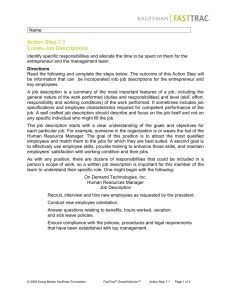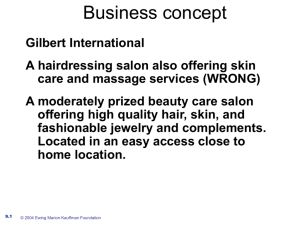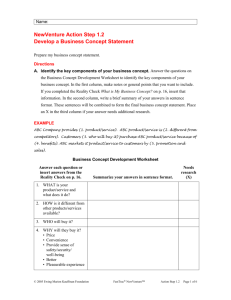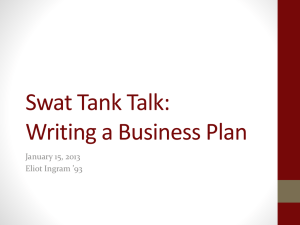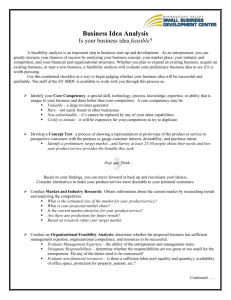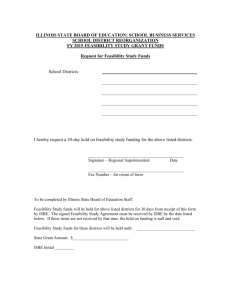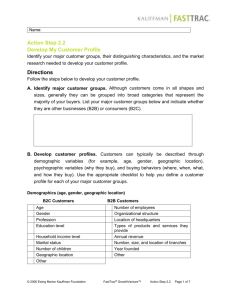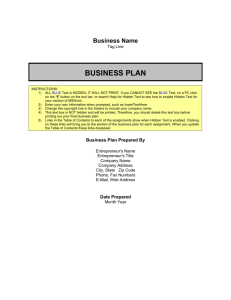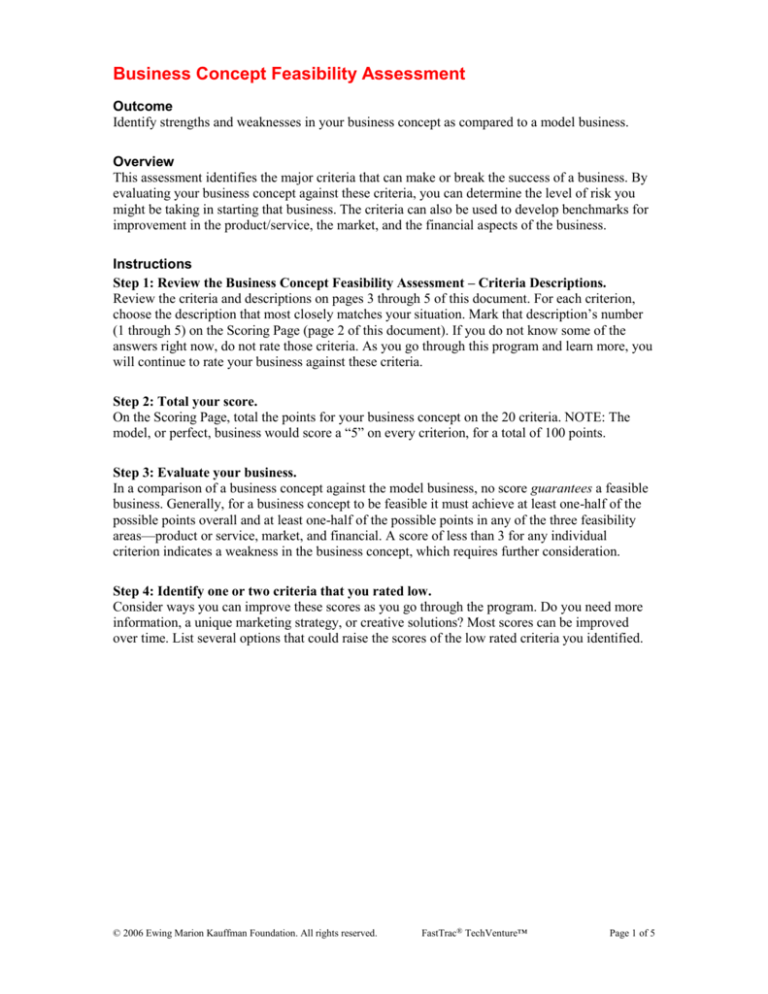
Business Concept Feasibility Assessment
Outcome
Identify strengths and weaknesses in your business concept as compared to a model business.
Overview
This assessment identifies the major criteria that can make or break the success of a business. By
evaluating your business concept against these criteria, you can determine the level of risk you
might be taking in starting that business. The criteria can also be used to develop benchmarks for
improvement in the product/service, the market, and the financial aspects of the business.
Instructions
Step 1: Review the Business Concept Feasibility Assessment – Criteria Descriptions.
Review the criteria and descriptions on pages 3 through 5 of this document. For each criterion,
choose the description that most closely matches your situation. Mark that description’s number
(1 through 5) on the Scoring Page (page 2 of this document). If you do not know some of the
answers right now, do not rate those criteria. As you go through this program and learn more, you
will continue to rate your business against these criteria.
Step 2: Total your score.
On the Scoring Page, total the points for your business concept on the 20 criteria. NOTE: The
model, or perfect, business would score a “5” on every criterion, for a total of 100 points.
Step 3: Evaluate your business.
In a comparison of a business concept against the model business, no score guarantees a feasible
business. Generally, for a business concept to be feasible it must achieve at least one-half of the
possible points overall and at least one-half of the possible points in any of the three feasibility
areas—product or service, market, and financial. A score of less than 3 for any individual
criterion indicates a weakness in the business concept, which requires further consideration.
Step 4: Identify one or two criteria that you rated low.
Consider ways you can improve these scores as you go through the program. Do you need more
information, a unique marketing strategy, or creative solutions? Most scores can be improved
over time. List several options that could raise the scores of the low rated criteria you identified.
© 2006 Ewing Marion Kauffman Foundation. All rights reserved.
FastTrac® TechVenture™
Page 1 of 5
Business Concept Feasibility Assessment – Scoring Page
For help with rating, see the criteria explanations on the following pages.
PRODUCT OR SERVICE FEASIBILITY
1
2
3
4
5
Customers perceive a need for product/service.
❑
❑
❑
❑
❑
Product/Service is ready to sell.
❑
❑
❑
❑
❑
Product/Service has unlimited life.
❑
❑
❑
❑
❑
Product/Service is unique and protectable.
Product/Service is not regulated by the
government.
Product/Service line has expansion potential.
❑
❑
❑
❑
❑
❑
❑
❑
❑
❑
❑
❑
❑
❑
❑
Product/Service has no liability risk.
❑
❑
❑
❑
❑
MARKET FEASIBILITY
1
2
3
4
5
Market can be recognized and measured.
❑
❑
❑
❑
❑
Existing competition has identifiable weaknesses.
❑
❑
❑
❑
❑
Distribution system is established and receptive.
❑
❑
❑
❑
❑
Customers purchase frequently.
❑
❑
❑
❑
❑
Business has great news value.
❑
❑
❑
❑
❑
FINANCIAL FEASIBILITY
1
2
3
4
5
Funding is easily obtained.
❑
❑
❑
❑
❑
Revenue stream is continuous.
❑
❑
❑
❑
❑
Money is collected prior to sales.
❑
❑
❑
❑
❑
Hiring and retaining employees is easy.
❑
❑
❑
❑
❑
Inventory/Service providers are dependable.
❑
❑
❑
❑
❑
Gross margin is 100 percent.
❑
❑
❑
❑
❑
Legal problems do not exist.
❑
❑
❑
❑
❑
Wealth is generated through exit strategy.
❑
❑
❑
❑
❑
Total Points Possible: 100
TOTAL FOR YOUR BUSINESS CONCEPT: _____
© 2006 Ewing Marion Kauffman Foundation. All rights reserved.
FastTrac® TechVenture™
Page 2 of 5
Business Concept Feasibility Assessment –
Criteria Descriptions
For each criterion in the left column below and on the following pages, read the five descriptions
in the right column. Choose the description that most closely matches your situation. Mark that
description’s number (1 through 5) on the Scoring Page (page 2 of this document).
PRODUCT OR SERVICE FEASIBILITY
Customers don’t know anything about my products/services.
Customers must be educated about my products/services before they see a need.
Customers must be convinced to buy from me instead of my competitors.
Customers need my products/services and will often select them over competitors’.
My customers need my products/services and want to buy from me.
Customers perceive
a need for product/
service.
1.
2.
3.
4.
5.
Product/Service is
ready to sell.
1. I have not started developing my product/service.
2. I could have problems; I’m still developing my products/services.
3. I have sold some products/services, but they are not completely tested or trouble
free.
4. I have thoroughly tested my products/services and am fixing the problems.
5. It’s all figured out! My products/services work well with minimal problems.
Product/Service has
unlimited life.
1.
2.
3.
4.
5.
My products/services must be sold quickly so they don’t perish or become obsolete.
My products/services have a relatively short life cycle which makes profits minimal.
I can make a profit before the life cycle ends for my products/services.
My products/services have a fairly long life cycle which will allow for ample profits.
My products/services can be sold forever! The life cycle is unlimited.
Product/Service is
unique and
protectable.
1.
2.
3.
4
5.
I just don’t have anything proprietary; all I offer is similar to the competition.
My product/service is not proprietary, but it stands out from the competition.
I’m going to do my best to create proprietary rights for my products/services.
My product is somewhat unique in function or style and can be legally protected.
My products are unique in function and style and can be legally protected.
Product/Service is
not regulated by the
government.
1.
2.
3.
4.
5.
Yikes! Complying with regulations is going to require lots of time and money.
The regulations are undergoing change, possibly requiring more time and expense.
It’s okay. The regulations are reasonable, but I’ll have to watch them closely.
It’s easy to comply with regulations for my specific products/services.
I’m free! Regulations are limited to those imposed on all businesses.
Product/Service line
has expansion
potential.
1.
2.
3.
4.
5.
My product/service has no expansion potential.
Right now, I only have one product/service to sell.
Definite expansion potential. Will require hard work to make it happen.
I have the beginnings of a product/service line with several things to sell.
My products/services complement each other, and I can easily add more to sell.
Product/Service has
no liability risk.
1.
2.
3.
4.
5.
I’m worried; I may encounter a large legal risk selling my products/services.
I’m not sure what the risks are in selling my products/services.
I can afford to protect myself for the risk involved in selling my products/services.
I will have minimal risk selling my products/services; I can afford to protect myself.
No problem! I’ll have no liability risk selling my products/services.
Continued on next page
© 2006 Ewing Marion Kauffman Foundation. All rights reserved.
FastTrac® TechVenture™
Page 3 of 5
MARKET FEASIBILITY
Market can be
recognized and
measured.
1. My customers could be just about anyone, so targeting a certain group may not be
easy.
2. I have many potential customers; I need to do more research to find my target market.
3. I have identified my potential customers, but they will be somewhat difficult to reach
because of their demographics/buying patterns.
4. With some effort, I can use my customers’ demographics/buying patterns to find them.
5. My potential customers are easy to find because of their demographics/buying
patterns.
Existing
competition
has identifiable
weaknesses.
1.
2.
3.
4.
5.
I have lots of competition who have been in this business longer than I.
I have no competition! Hmmm, I wonder why?
I have identified my competition, but I do not know their weaknesses.
I know my competition and their weaknesses, but I need more research.
I have limited competition, and I know their weaknesses.
Distribution
system is
established
and receptive.
1.
2.
3.
4.
5.
I must develop a brand new distribution system.
My current distribution system offers only limited options.
I’ve found a distribution system already established with several options.
Several distributors seem receptive to carrying my products/services.
Unbelievable! Distributors are calling me wanting to carry my products/services.
Customers
purchase
frequently.
1.
2.
3.
4.
5.
Customers will only buy once from me, so I must find new customers all the time.
Most customers will only buy once from me.
Customers will buy more than once, but not frequently.
Some customers will purchase products/services frequently.
My existing customers purchase products/services very frequently.
Business has
great news
value.
1.
2.
3.
4.
My business has zero news value.
My business just doesn’t seem to have great news value.
I think I can come up with an angle to get some publicity.
I know my business has news value, and I can get some good media coverage if I
work at it.
5. My business is so new and interesting that getting in the news is very easy.
Continued on next page
© 2006 Ewing Marion Kauffman Foundation. All rights reserved.
FastTrac® TechVenture™
Page 4 of 5
FINANCIAL FEASIBILITY
Funding is
easily
obtained.
1.
2.
3.
4.
5.
I’m going to have to invest a huge amount, maybe more than I am willing to risk.
I’m not really sure how much funding my business will require.
I need to invest quite a bit of money, but I can afford to risk it.
I need to invest a moderate amount of money; I can afford to risk it.
I don’t have to invest much money at all; I can comfortably risk it.
Revenue
stream is
continuous.
1.
2.
3.
4.
5.
I never know what’s going to come in because of seasonality, large contracts, etc.
Monthly sales will fluctuate significantly but are somewhat predictable.
Our sales vary somewhat from month to month due to sales cycles and products offered.
Most of the time, sales will be steady from month to month.
We can always count on steady sales from month to month.
Money is
collected prior
to sales.
1.
2.
3.
4.
5.
We send out a bill for products/services and wait over 30 days for customers to pay.
We send out a bill for products/services and the typical customer pays within 30 days.
Customers pay at the time of service or when they receive the product.
Our customers make an upfront deposit that covers the direct costs of the product/service.
Cash is king! The entire price of the product/service is paid prior to delivery.
Hiring and
retaining
employees is
easy.
1.
2.
3.
4.
5.
Turnover will be high. The cycle of hiring and training will be continuous.
I will spend lots of time and money hiring and training employees.
For now, I can control labor costs by using subcontractors as the company grows.
I have well-qualified employees and expect a low turnover rate.
This is great! I have top employees and a zero turnover rate!
Inventory/
Service
providers are
dependable.
1.
2.
3.
4.
5.
I do not have a clue where to get most of the inventory/supplies I need.
I’m not completely sure about where I’m going to get the inventory/supplies I need.
I’ve found them, but only a few companies can give me what I need.
Many companies can supply what I need.
No problem! Numerous companies with good reputations can supply what I need.
Gross margin
is 100 percent.*
1. My gross margin is low since our costs of direct materials and labor are high.
2. My gross margin is fairly low since our costs of direct materials and labor are relatively
high.
3. My gross margin is average with average costs of direct materials and labor.
4. We have some costs of direct materials and labor, but they are lower than average.
5. Nearly 100 percent! No significant direct costs of materials or labor exist.
Legal problems
do not exist.
1. I’ve got problems. I am already facing legal action. For example, violation of a non-compete
from a former employer.
2. I will have problems. I have multiple business owners, high liability products, leasing
issues, or products that must be legally protected.
3. I am concerned about protecting my personal assets from legal liability.
4. Legal problems do occur in this industry, but most can be anticipated and managed with
proper planning.
5. Few lawsuits or legal harassments occur in this entire industry.
Wealth is
generated
through exit
strategy.
1.
2.
3.
4.
5.
I will not be able to sell my business when I am ready to exit.
I don’t know if I can sell my business without me as the owner.
I will be able to sell some of the proprietary assets of the business.
I will be able to get a reasonable amount of money since I plan to build proprietary assets.
My exit strategy will allow for a profitable way out of the business.
*The gross margin is the amount left over after the business pays direct materials and labor costs of the
product or service.
© 2006 Ewing Marion Kauffman Foundation. All rights reserved.
FastTrac® TechVenture™
Page 5 of 5

